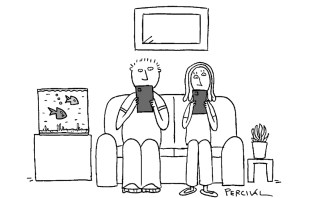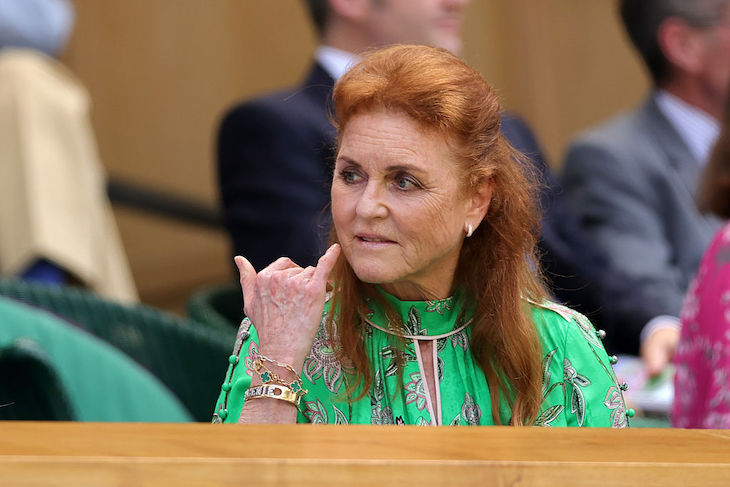Who could have foreseen that half a century after the sexual revolution we’d be facing its exact opposite: an asexual revolution? There’s a crisis of fertility across the West, with birth-rates and sperm counts in free fall. But this isn’t only about microplastics, oestrogen in the water or tight underpants. It’s also that the children of the West are choosing to have less sex – even no sex. A growing proportion actually identify as asexual, and rather than wait to see if the absence of lust is just a reasonable, youthful response to all the porn around in schools, they announce their asexuality solemnly to their friends and family.
It is aphobic, I’ve learnt, for anyone in a relationship with an asexual to ever ask them to put out
A fortnight ago a Gen Z journalist, Freya India, wrote a fascinating piece for The Spectator’s Life website suggesting that the boom in asexual kids is being caused by antidepressants. More than half the people who take happy pills are thought to experience some form of sexual dysfunction, she said, and in the UK a third of all teens have had them prescribed.
Freya makes a good case, but peering down from a few generations above, it’s hard to see what wouldn’t push a teen towards asexuality these days. There’s the exciting new fashion for strangling during sex, all the deathly dating via text, the absolute terror of ‘toxic’ masculinity. If you’re taught that fight or flight is the appropriate response to what we once called flirting, asexuality would be an obvious choice. So the kids, mostly the girls, ‘come out’ as asexual and then find themselves stuck with it; pinned in place by the label like moths on a collector’s board. No wonder they’re not procreating.
Last week Emmanuel Macron announced a set of incentives that he said was bound to encourage young people to breed – as if the right combination of tax breaks will crack some code and release a flood of babies. But all that the kids seem really keen on cooking up are ever more esoteric asexual identities. I learnt from a terrible Netflix series for teens that asexuals are known as ‘aces’. In this drama, all the straight boys were portrayed as either impotent or mentally ill (natch) and the gay hero was an ‘ace’. He had considered that he might be ‘greysexual’ (the odd flicker of lust on special occasions) but to his boyfriend’s serious disappointment decided not. Never mind. Love won the day and they stayed together – though as Douglas Murray has pointed out, it’s hard to find two groups with less in common than gay men and asexuals. Oddly an ace can also be ‘demisexual’ which means that they can be attracted to another person, but only after a strong emotional bond has been formed. The asexuals have reinvented women!
It’s all very teen girl, these ever-changing in-groups and out-groups, but the trouble is that teen-girl thinking is now embedded in adult society. In 2010 a civil servant called Robin who identifies as ace successfully persuaded the civil service to add the ‘A’ to its official LGBT group, which then became the LGBA&T network. Robin has made several contributions to increasing the visibility of asexuals within the service, she says, and if you can’t see why someone with no interest in sex would want to be more visible, then that’s your aphobia talking. It is also aphobic, I’ve learnt, for anyone in a relationship with an asexual to ask them to put out, even on your birthday, and definitely aphobic to suggest that they seek therapeutic help. That counts as ‘conversion therapy’. Asexuality brought on by trauma is its own separate identity thanks very much: caedsexuality, from the Latin caedere, to chop or cut out.
Aces have a history of persecution. Of course they do. You can’t be a legitimate minority without an oppression story. But what’s interesting is that their oppressors are often from within the queer ‘community’ (watch the revolution eating itself). As far as I can gather, the As weren’t instantly welcomed into the LGBTQIA+ gang because the Ts and the Qs weren’t quite sure that the As were discriminated against. Aggravating as the Ts often are, this does seem fair. How would any aphobes tell an ace from a non-ace? And how would they set about stopping one from not having sex?
But this pushback from the Ts gave the A-team just the break they needed. The fact they’d been excluded from LGBT groups, they said, proved that they were an oppressed minority – perhaps the most oppressed because they’d been rejected even by queer people. That’s some next level rainbow reasoning. I’ve now found various versions of this argument online and they’re all delightful, like the different formulations of St Anselm’s ontological argument. ‘Often times, people within the LGBT community gate-keep asexuals, their reasoning for this is that we haven’t experienced oppression,’ said one older Ace to an ace-curious girl. ‘This is quite ironic since gate-keeping the community is a prime example of oppression.’

I bring you asexuality because it’s Pride month shortly and for me it’s a relief just to know that there are committed celibates marching amid the leather men in pup masks. Also because it’s clearly not a coincidence that asexuality is growing fastest in the places where free love was once most widely proclaimed. In the same Bay Area haunts where men in fringed suede gang-banged stoned teens during the summer of love, you can now find the Ace SF [San Francisco] Book Club who this month are reading You Are Asexual by A.C. Evermore, a choose-your-own-adventure fantasy book: ‘A dragon-riding, vengeance-seeking lesbian! A cake themed asexual speakeasy! A fatal car chase! And the nefarious Consortium, hiding the truth behind Orientation Day! You get to choose! Where will your journey take you?’
‘Just the representation I was looking for,’ wrote one ace reviewer. ‘A good read but the sex scenes were too tame,’ wrote another. I honestly don’t think she was joking.
Watch Mary Wakefield and Mary Harrington discuss why Gen Z are choosing celibacy on Spectator TV:








Comments